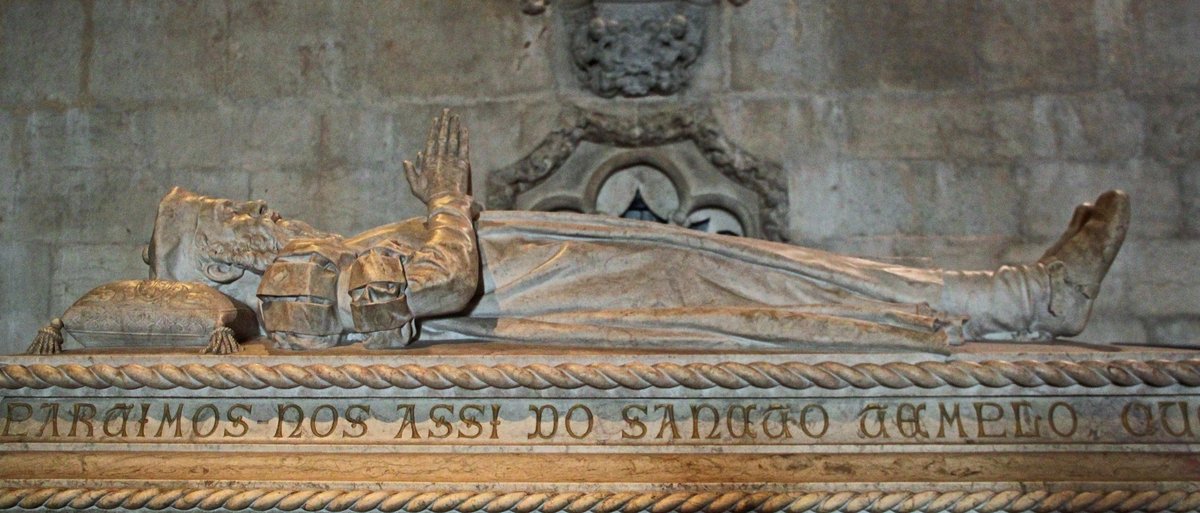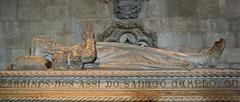
Jerónimos Monastery Visiting Hours, Tickets, and Lisbon Historical Sites Guide
Date: 14/06/2025
Introduction
Nestled in Lisbon’s historic Belém district, the Jerónimos Monastery stands as a breathtaking emblem of Portugal’s rich maritime heritage and artistic achievement. Commissioned in 1501 by King Manuel I, this UNESCO World Heritage Site commemorates Vasco da Gama’s groundbreaking voyage to India and symbolizes the nation’s Age of Discoveries—a pivotal era when Portugal emerged as a global seafaring power. The monastery’s exquisite Manueline architecture, characterized by intricate stonework adorned with maritime motifs such as ropes, armillary spheres, and sea creatures, reflects the wealth and cultural exchanges fostered by Portugal’s overseas ventures (Lisbon Guide; Headout).
Beyond its architectural splendor, Jerónimos Monastery holds deep religious, cultural, and political significance. Originally home to the Order of Saint Jerome, the monastery served as a spiritual sanctuary for sailors and the royal family, intertwining faith with exploration (Museus e Monumentos). Its cloisters and church house the tombs of national icons like Vasco da Gama, Luís de Camões, and King Manuel I, making it a pantheon of Portuguese identity (jeronimosmonastery.com).
Visitors today can explore the site from Tuesday to Sunday, between 10:00 AM and 5:30 PM, with tickets priced around €10 for general admission. Discounts are available, and accessibility measures, guided tours, and nearby attractions like Belém Tower and the Monument to the Discoveries enrich the visitor experience (The Tourist Checklist; Vacatis). Whether captivated by its architecture, history, or legacy, Jerónimos Monastery offers an immersive journey into Portugal’s illustrious past (Visit Lisboa; historyhit.com).
Historical Overview
Foundation and Purpose
Jerónimos Monastery, or Mosteiro dos Jerónimos, was founded to commemorate Vasco da Gama’s voyage to India and to serve as a gesture of gratitude to the Virgin Mary for that success. King Manuel I commissioned the monastery in 1501 near the Tagus River, symbolically placing it at the launching point of Portugal’s global expeditions (Lisbon Guide; Visit Lisboa). Managed by the Order of Saint Jerome, the monastery’s spiritual mission included praying for the king and supporting sailors embarking on new voyages (Museus e Monumentos). Construction was primarily financed by a tax on the spice trade, reflecting the immense wealth of Portugal’s overseas ventures.
Construction Timeline and Architectural Evolution
Construction began in 1501 and lasted over a century. The main church was completed in 1541 (jeronimosmonastery.com). The Manueline style, a Portuguese take on Late Gothic architecture, is evident in the elaborate stonework and maritime motifs. Over time, Renaissance and Mannerist elements were integrated, reflecting changing artistic trends (Lisbon Guide).
Role During the Age of Discoveries
The monastery is intrinsically linked to Portugal’s Age of Discoveries. Located in Belém, it was the spiritual starting point for explorers like Vasco da Gama. The monastery symbolized national aspirations and was a direct beneficiary of wealth from trade and conquest (Lisbon Guide; Visit Lisboa).
Historical Events and Restorations
The 1755 Lisbon Earthquake caused significant damage, but restoration efforts preserved much of the original grandeur (jeronimosmonastery.com). The monastery was used as barracks during the Napoleonic Wars and was secularized in 1833, after which restoration and repurposing began (Museus e Monumentos). It was classified as a National Monument in 1907 and inscribed as a UNESCO World Heritage Site in 1983 (Visit Lisboa; Museus e Monumentos).
Architectural and Cultural Highlights
Manueline Style
Jerónimos Monastery is the best-known example of the Manueline style, characterized by:
- Ornate maritime motifs (ropes, knots, shells, sea monsters)
- Armillary spheres and crosses of the Order of Christ
- Lavish local limestone work (Lisbon Guide; Headout)
The Church of Santa Maria de Belém
- Supported by slender columns, the nave features a single, unbroken vaulted ceiling—a technical marvel for its time.
- The high choir is decorated with wooden stalls; main altar and side chapels feature gilded Manueline woodwork.
- The church contains the tombs of Vasco da Gama, Luís de Camões, and King Manuel I (jeronimosmonastery.com).
Cloisters
The two-story cloisters, designed by Diogo de Boitaca and João de Castilho, are renowned for sculptural detail and tranquil atmosphere:
- Arcades with intricate carvings
- Ribbed vaulted ceilings adorned with coats of arms and armillary spheres
- Symbolism throughout: armillary spheres, botanical motifs, and crosses of the Order of Christ
- Notable spaces include the chapter house and the refectory decorated with 18th-century azulejo tiles (LisbonLisboaPortugal.com)
The Refectory and Chapter House
The refectory features blue-and-white azulejos and a prominent biblical panel. The chapter house has a ribbed vaulted ceiling and notable acoustics.
Museums and Gardens
The west wing houses the Maritime Museum and National Archaeology Museum. The formal gardens at the entrance enhance the site’s grandeur (Headout).
Visiting Information
Location and Access
- Address: Praça do Império, 1400-206 Lisboa, Portugal (Trip.com)
- Transport: Tram 15E, buses 727 and 28, Belém train station, or ferry via the Belém terminal. Walking from central Lisbon is possible with scenic views.
Opening Hours
- Tuesday to Sunday: 10:00 AM – 5:30 PM (last entry at 5:00 PM)
- Closed: Mondays, January 1, Easter Sunday, May 1, December 25
Tickets
- General Admission: ~€10 for visitors aged 13 and above (Vacatis)
- Discounts: ~€5 for EU citizens aged 18-25, free for children under 13, Lisbon residents, and seniors over 65
- Entry: Free to the church; tickets required for cloisters and museum
- Purchase: Online strongly recommended to avoid queues (Vacatis; Lisbon Tourist Information)
Accessibility
- Wheelchair accessible paths, ramps, and adapted restrooms. Some areas may have limited access due to historic features (The Tourist Checklist).
Visitor Facilities
- Restrooms and seating throughout the grounds
- Gift shop offering books, souvenirs, and crafts
- Photography allowed (no flash/tripods in some areas)
What to See and Do
- South Portal: Marvel at the elaborate entrance and sculptures (LisbonLisboaPortugal.com).
- Nave and Columns: Observe the slender, sculpted columns and vaulted ceiling.
- Cloisters: Explore both levels for symbolic carvings and tranquility.
- Tombs: Pay respects at the tombs of Vasco da Gama, Luís de Camões, and royals.
- Refectory: Admire azulejo panels and the serene atmosphere.
- Gardens: Enjoy the formal approach and views of the grand façade.
- Museums: Maritime and Archaeology Museums in the west wing.
Practical Tips
- Best Time: Early morning or late afternoon for fewer crowds; weekdays (Tues-Thurs) are quieter.
- Footwear: Wear comfortable shoes—stone paths and stairs.
- Visit Duration: 1.5–2 hours for a thorough visit.
- Combine Visits: Pair with Belém Tower and other local sites.
- Weather: Prepare for the outdoors with sun/rain protection.
- Guided Tours: Available and recommended for historical context.
Nearby Attractions
- Belém Tower: Iconic fortress and UNESCO site
- Monument to the Discoveries: Celebrates Portugal’s explorers
- National Coach Museum: Royal coaches collection
- Pastéis de Belém: Famous local bakery
Frequently Asked Questions (FAQs)
Q: What are the Jerónimos Monastery visiting hours?
A: Tuesday to Sunday, 10:00 AM to 5:30 PM; closed on Mondays and select holidays.
Q: How much do tickets cost?
A: €10 for adults, discounts for youth, seniors, and free for children under 13.
Q: Are guided tours available?
A: Yes, in multiple languages with audio guides and virtual options.
Q: Is the monastery accessible for people with disabilities?
A: Yes, with ramps and adapted facilities (some areas limited).
Q: What are the best times to visit?
A: Early mornings, late afternoons, and weekdays outside peak season.
Q: Can I buy tickets online?
A: Yes, online purchase is recommended (Vacatis).
Visuals and Media
For a virtual tour, visit the official Jerónimos Monastery virtual tour.
Visitor Feedback
Jerónimos Monastery is highly rated for its peaceful atmosphere, stunning architecture, and cultural significance. Visitors recommend exploring slowly and combining the visit with other Belém attractions for a full cultural experience (The Tourist Checklist).
Conclusion
Jerónimos Monastery remains a must-visit for anyone interested in Portugal’s Age of Discovery and its enduring impact on world history. Its signature Manueline style, rich historical layers, and central role in national identity make it an essential Lisbon landmark. With accessible visiting hours, various ticket options, and proximity to other major sites, your visit can be as informative as it is inspiring. Plan ahead for the best experience—purchase tickets online, check current hours, and consider guided tours. Download the Audiala app for updates and guided content, and immerse yourself in one of Europe’s great historical treasures.
Sources and Further Reading
- Jerónimos Monastery Visiting Hours, Tickets, and History | Lisbon Historical Sites Guide (Lisbon Guide)
- Jerónimos Monastery Architectural Highlights: Visiting Hours, Tickets & History (Headout)
- Cultural and Political Significance of Jerónimos Monastery (benloomis.substack.com)
- Jerónimos Monastery Official Website (jeronimosmonastery.com)
- Visit Lisboa - Jerónimos Monastery (Visit Lisboa)
- Museus e Monumentos - Mosteiro dos Jerónimos (Museus e Monumentos)
- Visiting Jerónimos Monastery: Hours, Tickets, and Exploring Lisbon’s Historic Gem (The Tourist Checklist)
- Jerónimos Monastery Tickets and Visitor Information (Vacatis)
- History Hit - Jerónimos Monastery (historyhit.com)



























































